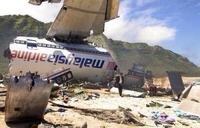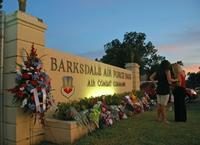-
Plans for nationwide 911 dispatch centers advance
Municipalities across the country are planning to connect 911 dispatch centers in an effort to improve information sharing. Plan is to connect dispatchers via the Internet, which will allow centers quickly to transfer calls, 911 text messages, photos, videos of accident scenes, and other information. The technology is part of a “Next Generation 911” initiative already being implemented across the country.
-
-
Forensic technology could help U.S. prove case against Russia, Ukrainian separatists

Over the weekend, U.S. Secretary of State John Kerry appeared on several media outlets to make a case against Russia for the country’s support of pro-Russian separatists responsible for the downing of Malaysia Airlines Flight MH17. The United States is confident that rebels attacked the airplane with an SA-11 Gadfly 9K37M1 Buk-1M fired missile. For the United States to prove its allegations against Russia and the Ukrainian separatists, Western authorities must first gain full access to the crash site, utilize an arsenal of forensic investigative technology, then gather eye witness accounts. Once the United States can prove its allegations, European partners can then be persuaded to impose tougher sanctions on Russia.
-
-
Fire shuts down nuclear repository, but DOE still recognizes operator for “excellent” performance
Five days after an underground truck fire closed the Waste Isolation Pilot Plant (WIPP), the Energy Department (DOE) awarded Nuclear Waste Partnership (NWP), the operating contractor of the nuclear repository, $1.9 million for “excellent” performance during the past year.Shortly after the truck fire, WIPP was shut down because of radiation leak, Still, “No federal or contractor official has lost their job, been transferred, been moved off the WIPP contract or otherwise held accountable. No leadership has changed at the federal level. No company has lost a contract,” noted an industry observer.
-
-
Barksdale AFB to be upgraded so it could store nuclear weapons on site

In 2009, the Louisiana congressional delegation successfully fought for locating the Global Strike Command at Barksdale Air Force base. Barksdale, home to the Global Strike Command, is No. 2 on the Air Force’s priority list of nuclear weapons storage areas set to receive an upgrade so Barksdale can safety store the U.S. nuclear weapons and load the weapons onto B-52s. The B-52s stationed at Barksdale AFB currently fly to other installations to load nuclear weapons onboard. Language inserted last week into the bill that funds the Department of Defense (DOD) for FY15 requires the Air Force to develop a detailed plan within ninety days of the bill becoming law on how it will modernize the U.S. five nuclear weapons storage areas, including the one at Barksdale Air Force Base.
-
-
First federal funds for West Coast earthquake warning system
Efforts by California officials to expand an earthquake warning system for the West Coast gained ground last Tuesday as the House Appropriations Committeerecommended $5 million — the first federal funds specifically for the project — toward the warning system. Analysts project the system will cost $38.3 million to build, and $16.1 million a year to operate and maintain. The $5 million would allow the purchase and installation of additional sensors and hiring of staff.
-
-
FBI: driverless cars could be used as bombs-on-wheels

Whether or not a driverless car, from Google or any other company, ever makes it to market, the FBI thinks it may be a “game changing” vehicle which could dramatically change high-speed car chases so that the pursued vehicle would have an advantage over the pursuing car. An agency report also warned that such cars may be used as “lethal weapons.”
-
-
DHS urged to investigate use of DHS grants for Motorola emergency comm. devices
Three senior House Democrats have requested DHS’s Office of Inspector Generalto investigate allegations claiming Motorola’s contracting tactics have led state and local governments unnecessarily to spend millions of dollars on the company’s proprietary devices, including its two-way emergency radio systems.
-
-
A drone finds natural disaster survivors through their cell-phones
During his semester project in Computer Science at the École polytechnique fédérale de Lausanne (EPFL), Jonathan Cheseaux developed a system for locating a person via his or her mobile phone with a drone. This device could be used to find victims in natural disasters.
-
-
Tennessee man pleads guilty to attempting to extort a nuclear contractor
Adam Winters, 26, of Robbins, Tennessee, has pleaded guilty in a $2.5 million extortion case involving Babcock and Wilcox, a managing contractor at the Y-12 National Security Complex in Oak Ridge. According to Oak Ridge Today, Winters sent the contractors an e-mail on 8 May, threatening to injure their reputation by publishing roughly 1,200 slides containing evidence from nuclear testing, including the amount of radiation used on animals.
-
-
Training volcano scientists from around the world to predict, respond to eruptions

Scientists and technicians who work at volcano observatories in eleven countries visited the U.S. Geological Survey’s Hawaiian Volcano Observatory earlier this month to learn techniques for monitoring active volcanoes. The International Training Program in Volcano Hazards Monitoring is designed to assist scientists from other nations in attaining self-sufficiency in monitoring volcanoes and reducing the risks from eruptions.
-
-
Using drones in law enforcement work
Using unmanned flight systems for domestic surveillance can provide emergency responders information during fires, earthquakes, storms, and man-made disasters, said John Hill, director of the Indiana Department of Homeland Security.He said that the general public is open to the use of unmanned systems when informed about their use.
-
-
Cloud computing poses technical challenges for digital crime-fighters
The ultimate in distributed computing, cloud computing is revolutionizing how digital data is stored, processed, and transmitted. It enables convenient, on-demand network access to a shared pool of configurable computing resources, including servers, storage, and applications. The characteristics that make this new technology so attractive also create challenges for forensic investigators who must track down evidence in the ever-changing, elastic, on-demand, self-provisioning cloud computing environments.
-
-
California braces for worst wildfire season in memory
California Department of Forestry and Fire Protection(Cal Fire) is bracing for one of the longest and most difficult fire seasons in memory. A recent addition of $23 million to the emergency wildfire budget for the fiscal year that began 1 July, brings the department’s budget total to $209 million. “That’s just the first week, and we still have 51 more weeks to go,” said Daniel Berlant, spokesman for Cal Fire. “We’re not even to the peak of the fire season yet.”
-
-
DARPA seeks to speed new materials development process
Military platforms — such as ships, aircraft, and ground vehicles — rely on advanced materials to make them lighter, stronger, and more resistant to stress, heat, and other harsh environmental conditions. Currently, the process for developing new materials to field in platforms frequently takes more than a decade. DARPA seeks to address this problem by developing a methodology and toolset to compress the applied material development process by at least 75 percent: from an average of ten years or longer to just two and a half years.
-
-
As budget shrinks, DOD needs to rethink strategy to preserve U.S. technological edge
The United States currently accounts for less than one-third of global research and development spending, and this fraction is projected to decline to 18 percent by 2050. Those statistics, together with the recognition that the United States no longer maintains superiority across all research fields, mean that DOD’s technological leadership now depends upon its ability to identify and leverage relevant research advances as they emerge from the global science and technology enterprise, says a new report from the National Research Council.
-
More headlines
The long view
Factories First: Winning the Drone War Before It Starts
Wars are won by factories before they are won on the battlefield,Martin C. Feldmann writes, noting that the United States lacks the manufacturing depth for the coming drone age. Rectifying this situation “will take far more than procurement tweaks,” Feldmann writes. “It demands a national-level, wartime-scale industrial mobilization.”
How Male Grievance Fuels Radicalization and Extremist Violence
Social extremism is evolving in reach and form. While traditional racial supremacy ideologies remain, contemporary movements are now often fueled by something more personal and emotionally resonant: male grievance.
The Surprising Reasons Floods and Other Disasters Are Deadlier at Night
It’s not just that it’s dark and people are asleep. Urban sprawl, confirmation bias, and other factors can play a role.
Why Flash Flood Warnings Will Continue to Go Unheeded
Experts say local education and community support are key to conveying risk.
